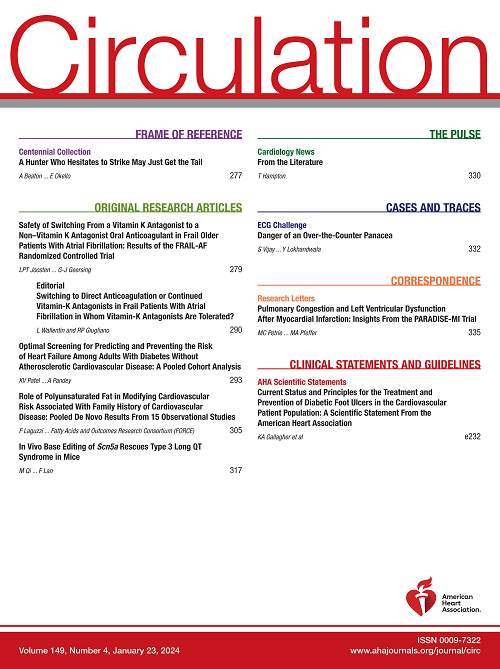Extracellular RIPK3 Acts as a Danger-Associated Molecular Pattern to Exaggerate Cardiac Ischemia/Reperfusion Injury.
IF 35.5
1区 医学
Q1 CARDIAC & CARDIOVASCULAR SYSTEMS
引用次数: 0
Abstract
BACKGROUND Cardiac ischemia/reperfusion (I/R) injury has emerged as an important therapeutic target for ischemic heart disease. Currently, there is no effective therapy for reducing cardiac I/R injury. Damage-associated molecular patterns are endogenous molecules released after cellular damage to exaggerate tissue inflammation and injury. RIPK3 (receptor-interacting protein kinase 3), a well-established intracellular mediator of cell necroptosis and inflammation, serves as a circulating biomarker of multiple diseases. However, whether extracellular RIPK3 also exerts biological functions in cardiac I/R injury remains totally unknown. METHODS Patients with acute myocardial infarction receiving percutaneous coronary intervention (PCI) were recruited independently in the discovery cohort (103 patients) and validation cohort (334 patients), and major adverse cardiovascular events were recorded. Plasma samples were collected before and after PCI (6 and 24 h) for RIPK3 concentration measurement. Cultured neonatal rat ventricular myocytes, macrophages and endothelial cells, and in vivo mouse models with myocardial injury induced by I/R (or hypoxia/reoxygenation) were used to investigate the role and mechanisms of extracellular RIPK3. Another cohort including patients with acute myocardial infarction receiving PCI and healthy volunteers was recruited to further explore the mechanisms of extracellular RIPK3. RESULTS In the discovery cohort, elevated plasma RIPK3 levels after PCI are associated with poorer short- and long-term outcomes in patients with acute myocardial infarction, as confirmed in the validation cohort. In both cultured cells and in vivo mouse models, recombinant RIPK3 protein exaggerated myocardial I/R (or hypoxia/reoxygenation) injury, which was alleviated by the RIPK3 antibody. Mechanistically, RIPK3 acted as a damage-associated molecular pattern and bound with RAGE (receptor of advanced glycation end-products), subsequently activating CaMKII (Ca2+/calmodulin-dependent kinase II) to elicit the detrimental effects. The positive correlation between plasma RIPK3 concentrations and CaMKII phosphorylation in human peripheral blood mononuclear cells was confirmed. CONCLUSIONS We identified the positive relationship between plasma RIPK3 concentrations and the risk of major adverse cardiovascular events in patients with acute myocardial infarction receiving PCI. As a damage-associated molecular pattern, extracellular RIPK3 plays a causal role in multiple pathological conditions during cardiac I/R injury through RAGE/CaMKII signaling. These findings expand our understanding of the physiological and pathological roles of RIPK3, and also provide a promising therapeutic target for myocardial I/R injury and the associated complications.细胞外 RIPK3 作为一种危险相关分子模式加剧心脏缺血/再灌注损伤
背景心脏缺血/再灌注(I/R)损伤已成为缺血性心脏病的重要治疗目标。目前,还没有减少心脏 I/R 损伤的有效疗法。损伤相关分子模式是细胞损伤后释放的内源性分子,可加剧组织炎症和损伤。RIPK3(受体相互作用蛋白激酶 3)是一种公认的细胞内细胞坏死和炎症介质,是多种疾病的循环生物标志物。方法在发现队列(103 名患者)和验证队列(334 名患者)中独立招募接受经皮冠状动脉介入治疗(PCI)的急性心肌梗死患者,并记录主要不良心血管事件。在PCI前后(6小时和24小时)采集血浆样本,测量RIPK3的浓度。研究人员利用培养的新生大鼠心室肌细胞、巨噬细胞和内皮细胞,以及I/R(或缺氧/复氧)诱导的心肌损伤体内小鼠模型,研究细胞外RIPK3的作用和机制。结果在发现队列中,PCI 后血浆 RIPK3 水平升高与急性心肌梗死患者较差的短期和长期预后有关,验证队列也证实了这一点。在培养细胞和体内小鼠模型中,重组 RIPK3 蛋白会加重心肌 I/R(或缺氧/再氧合)损伤,而 RIPK3 抗体可减轻这种损伤。从机理上讲,RIPK3作为一种损伤相关分子模式,与RAGE(高级糖化终产物受体)结合,随后激活CaMKII(Ca2+/钙调蛋白依赖性激酶II),从而引发损伤效应。结论我们发现血浆 RIPK3 浓度与接受 PCI 治疗的急性心肌梗死患者发生主要不良心血管事件的风险呈正相关。作为一种损伤相关分子模式,细胞外 RIPK3 通过 RAGE/CaMKII 信号转导在心脏 I/R 损伤期间的多种病理情况中起着因果作用。这些发现拓展了我们对 RIPK3 生理和病理作用的认识,同时也为心肌 I/R 损伤及其相关并发症提供了一个很有前景的治疗靶点。
本文章由计算机程序翻译,如有差异,请以英文原文为准。
求助全文
约1分钟内获得全文
求助全文
来源期刊

Circulation
医学-外周血管病
CiteScore
45.70
自引率
2.10%
发文量
1473
审稿时长
2 months
期刊介绍:
Circulation is a platform that publishes a diverse range of content related to cardiovascular health and disease. This includes original research manuscripts, review articles, and other contributions spanning observational studies, clinical trials, epidemiology, health services, outcomes studies, and advancements in basic and translational research. The journal serves as a vital resource for professionals and researchers in the field of cardiovascular health, providing a comprehensive platform for disseminating knowledge and fostering advancements in the understanding and management of cardiovascular issues.
 求助内容:
求助内容: 应助结果提醒方式:
应助结果提醒方式:


